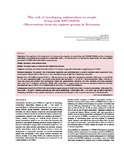| dc.contributor.author | Nnyepi, M.S. | |
| dc.date.accessioned | 2011-12-06T13:44:41Z | |
| dc.date.available | 2011-12-06T13:44:41Z | |
| dc.date.issued | 2009 | |
| dc.identifier.citation | Nnyepi, M.S. (2009) The risk of developing malnutrition in people living with HIV/AIDS: observations from six support groups in Botswana, South African Journal of Clinical Nutrition, Vol. 22, No. 2, pp. 89-94 | en_US |
| dc.identifier.issn | 0038-2469 | |
| dc.identifier.uri | http://hdl.handle.net/10311/966 | |
| dc.description | Some symbols in the abstract may not be the same as in the original abstract. | en_US |
| dc.description.abstract | Objectives: The objectives of this study were to 1)to determine the proportion of people living with HIV/AIDS (PLWHA) at risk of developing malnutrition, 2) to determine the prevalence of malnutrition (BMI < 18.5 kg/m2, and 3)to describe the dietary intake and other nutrition parameters of PLWHA with membership in support groups.
Design: Descriptive cross-sectionals study.
Setting: Six support groups in Gaborone and neighboring locations.
Subjects: Consenting, free- living HIV-positive adults 20-50 years of age with membership in support groups PLWHA.
Outcome measures: The subjects' risk of developing malnutrition was established using a modified subjective global assessment (SGA)screening tool. Subjects with an SGA score ≥ 4 were classified as being at high risk of developing malnutrition. Results: From 145 PLWHA screened, 47.5% (n=69)were found to be at high risk of developing malnutrition (SGA score ≥ 4) and 28.5%(n=41) were malnourished (BMI <18.5 kg/m2). In the sample with SGA scores ≥ 4, 52.2% (n=35) presented with BMI <18.5 kg/m2. These two groups also reported more unintentional weight loss, gastrointestinal symptoms, and other conditions commonly associated with a high risk of developing malnutrition. PLWHA with membership in support groups also had low educational attainment and high unemployment rates. A total of 47% of subjects with an SGA score ≥ 4 needed food assistance. Conclusions: Almost 50% of PLWHA with membership in support groups for PLWHA are at risk of developing malnutrition, while about 30% have a BMI <18.5 kg/m2. Nutrition screening can also help to identify those PLWHA with BMI>18.5 kg/m2 who are still at high risk of developing malnutrition. Timely nutrition interventions can therefore be instituted in order to prevent deterioration in nutritional status. | en_US |
| dc.language.iso | en | en_US |
| dc.publisher | Medpharm Publications (Pty) Ltd., http://www.medpharm.co.za | en_US |
| dc.subject | Malnutrition | en_US |
| dc.subject | HIV/AIDS | en_US |
| dc.subject | Botswana | en_US |
| dc.title | The risk of developing malnutrition in people living with HIV/AIDS: observations from six support groups in Botswana | en_US |
| dc.title.alternative | Malnutrition in support groups of people living with HIV/AIDS (PLWHA): a case in Botswana | en_US |
| dc.type | Published Article | en_US |
| dc.link | http://www.sajcn.co.za/index.php/SAJCN/article/view/248 | en_US |

